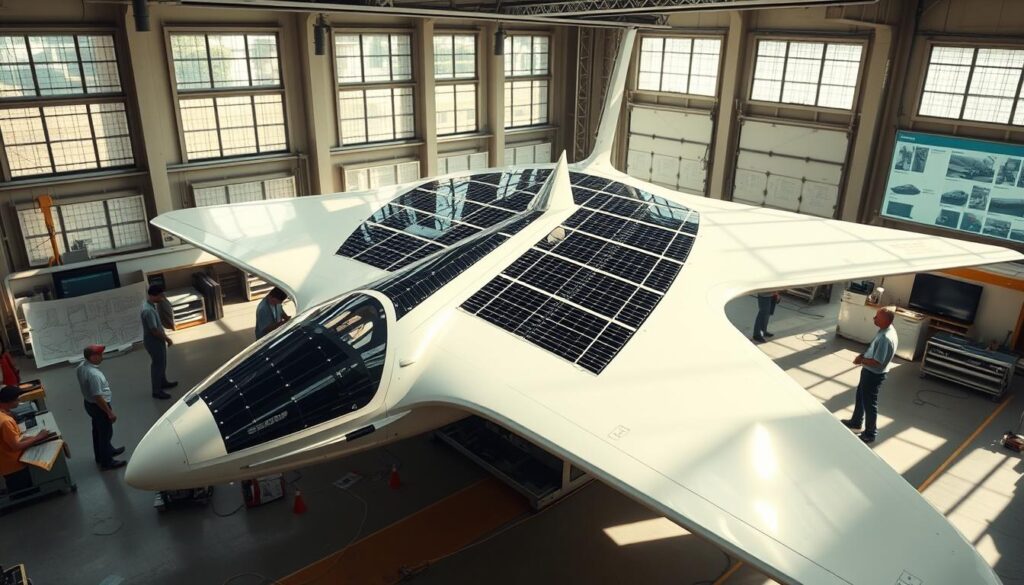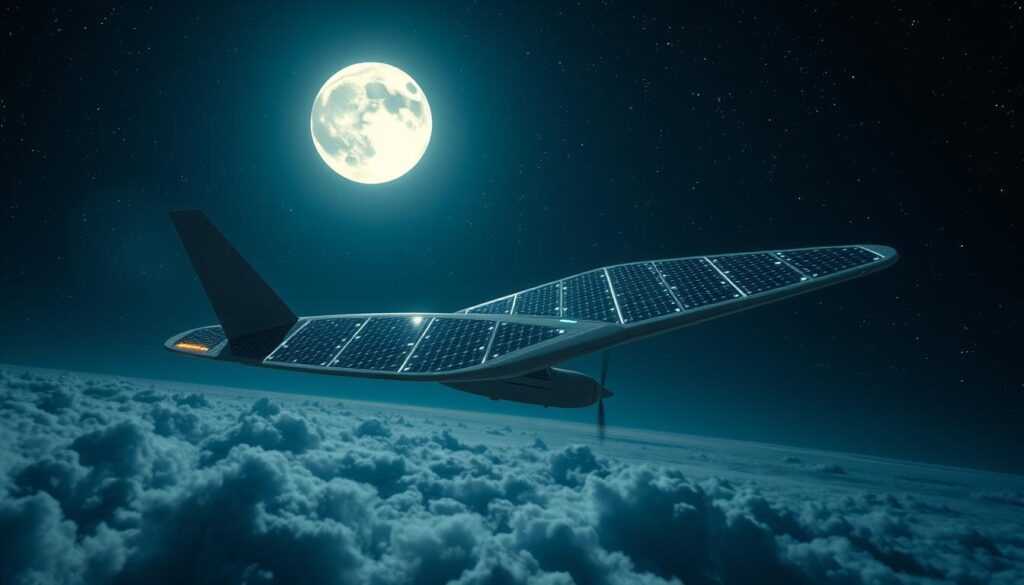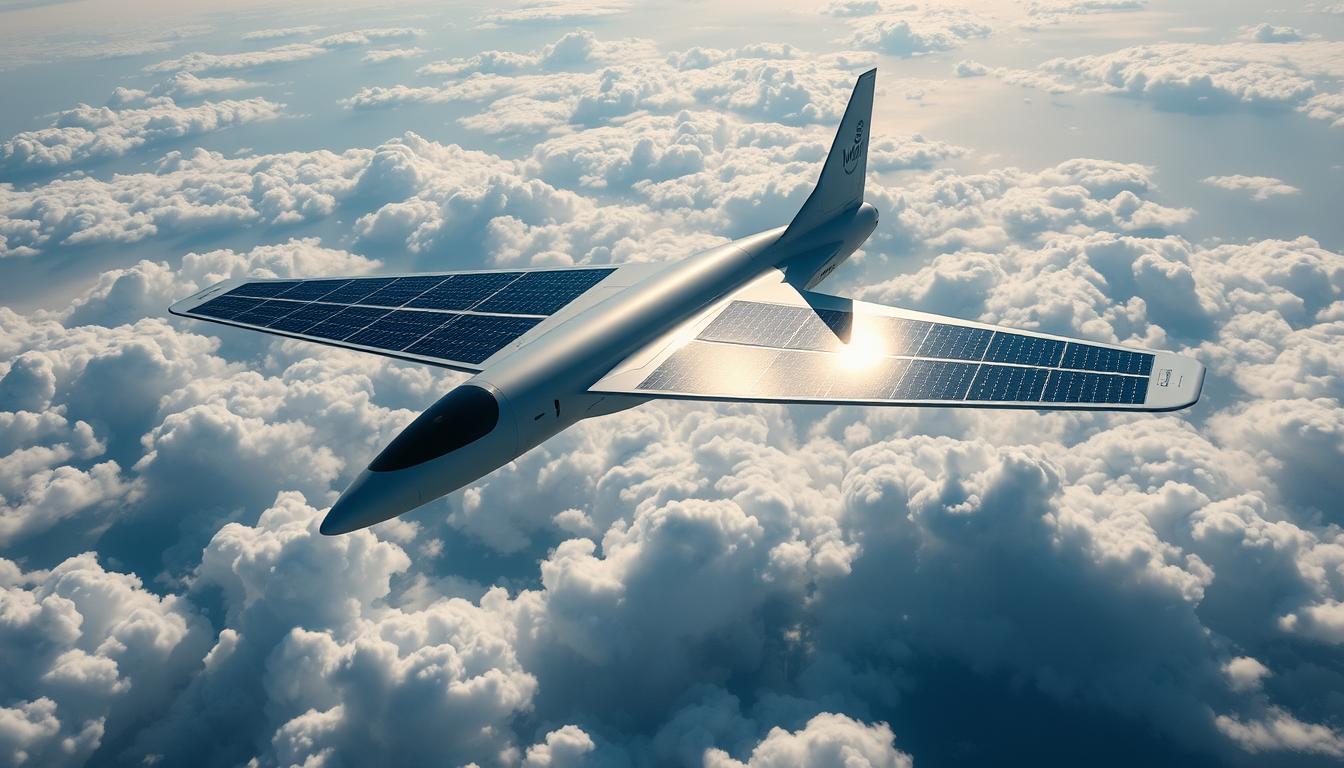Imagine an aircraft flying around the world without using any fuel. Solar Impulse made this dream a reality, becoming the first solar-powered plane to circle the globe. This incredible journey started in Switzerland and showed us what’s possible with clean technology and human creativity.
Key Takeaways
- Solar Impulse was the first aircraft to circumnavigate the globe powered solely by solar energy.
- Concrete steps towards sustainable aviation were taken with the success of this global flight.
- The project was initiated in Switzerland with a strong emphasis on renewable energy aviation.
- Solar Impulse symbolized what renewable energy technologies can achieve in the aviation industry.
- This pioneering feat inspired further innovation and research in the field of aviation technology.
Introduction to Solar Impulse
Solar Impulse is a groundbreaking project in solar aviation. It’s a Swiss long-range experimental solar-powered aircraft. It showed the power of clean technologies by flying around the world on solar power.
The Vision and Mission of Solar Impulse
The goal of Solar Impulse was to fly around the world on solar power. This proved that clean technologies can be efficient and scalable. It aimed to inspire a shift towards sustainable energy by demonstrating solar-powered flight.
Key Figures: Bertrand Piccard and André Borschberg
Bertrand Piccard and André Borschberg led Solar Impulse. Bertrand, a psychiatrist and balloonist, brought his adventurous spirit and vision for a sustainable future. André, an engineer and businessman, added his technical skills and strategic planning. Together, they aimed to complete a historic round the world solar flight and showcase what’s possible with solar-powered aircraft.
The Development of Solar Impulse Aircraft

The Solar Impulse aircraft’s journey shows how engineering and teamwork can lead to big leaps in aviation. It was a mix of careful planning, new tech, and partnerships.
Engineering and Technological Innovations
The Solar Impulse project was a game-changer in solar flight. A team of 50 engineers from six countries worked together. They had over 80 partners, including Omega SA, Solvay, ABB, and Schindler.
Solar Impulse’s success came from using light materials, efficient solar panels, and strong batteries. These were big steps forward in aviation.
Funding and Partnerships
Getting money was key for the Solar Impulse project. It got support from private companies and the Swiss government. Omega SA, Solvay, and ABB were big helpers, both with money and tech.
Peter Diamandis also gave a lot of help. His contributions were important for the project’s success.
| Contributor | Role |
|---|---|
| Omega SA | Financing and technological expertise |
| Solvay | Advanced materials |
| ABB | Electrical systems and innovations |
| Swiss Government | Funding and support |
| Peter Diamandis | Individual financial contributions |
What Plane Conducted the First Solar Powered Flight Around the World
Solar Impulse 2 is a major breakthrough in solar-powered flight. It showed that solar energy can power planes to fly around the world. This achievement is a big step for renewable energy in aviation.
Specifications and Features of Solar Impulse 2
The specifications of solar powered aircraft like Solar Impulse 2 show big tech advances. This plane has:
- A wingspan of 72 meters, bigger than a Boeing 747.
- It’s as light as a family car, thanks to special materials.
- It has 17,248 photovoltaic cells in its wings to turn sunlight into power.
- It uses four electric motors that are very efficient.
- It also has batteries to keep flying at night.
Comparison with Solar Impulse 1
The move from Solar Impulse 1 to Solar Impulse 2 shows big improvements. Here’s a comparison:
| Feature | Solar Impulse 1 | Solar Impulse 2 |
|---|---|---|
| Wingspan | 63.4 meters | 72 meters |
| Weight | 1,600 kg | 2,300 kg |
| Solar Cells | 11,628 | 17,248 |
| Endurance | Up to 26 hours | Potential for perpetuity |
These upgrades show how solar flight is getting better. They help planes like Solar Impulse 2 achieve amazing feats, like flying around the world on solar power.
The Milestone Flights of Solar Impulse

Solar Impulse has made a big mark in aviation history. It achieved many amazing things with its solar plane. These achievements have set new standards and opened up new possibilities for flying in a sustainable way.
First Test Flights
Solar Impulse 1 started its journey with a series of test flights in 2009. These early flights were key in improving the plane’s design and how it works. They set the stage for future flights and made history with solar-powered flights.
Solar Impulse 1’s Overnight Flight
In 2010, Solar Impulse 1 made history with the world’s first solar-powered overnight flight. This 26-hour flight showed the plane’s ability to use and store solar energy well. It proved that solar-powered flights could last long, even at night.
After this success, Solar Impulse 1 flew across Europe. It went from Switzerland to Belgium and France. These flights showed that solar-powered flying is not just possible but also promising for a cleaner future in aviation.
| Flight | Date | Duration | Notes |
|---|---|---|---|
| Pioneering Test Flights | 2009 | Various | Initial tests to refine design and functionality |
| Overnight Flight | 2010 | 26 hours | First manned solar-powered overnight flight |
| International Flights | 2011 | Various | Flights from Switzerland to Belgium and France |
The Historic Round the World Journey
In 2015, the Solar Impulse 2 started an incredible journey. It began in Abu Dhabi and aimed to cross continents and oceans. The plane traveled an amazing 42,000 km.
During this journey, Solar Impulse 2 faced many challenges. But it also reached incredible milestones. It flew without using any fuel, showing the power of renewable energy.
The team, led by Bertrand Piccard and André Borschberg, showed what solar aviation can do. They overcame weather and tech issues while keeping safety and sustainability first. The journey lasted 16.5 months, proving human determination and creativity.
The plane stopped at famous places, showing its ability to fly in different conditions. Each stop showed the commitment to green flying, inspiring people and companies everywhere. It made them think about new energy solutions.
When Solar Impulse 2 returned to Abu Dhabi, it had achieved something amazing. It had set a new standard for flying around the world using the sun. This journey showed that with hard work, new ideas, and believing in clean energy, we can reach for the sky.
Challenges Faced During the Journey
Solar Impulse’s journey was filled with technical and human hurdles. These challenges showed the need for advanced tech and human strength to reach such a goal.
Technical and Weather Challenges
The Solar Impulse project hit many technical roadblocks in solar flights. The team had to find creative fixes, like managing battery heat, to keep flying.
Weather also caused big delays. Clouds and storms forced changes in flight plans. This tested the aircraft and the team’s ability to adapt.
Human Challenges: Piloting and Endurance
The human side of Solar Impulse was just as tough. Pilots Bertrand Piccard and André Borschberg faced long flights in cold, cramped cabins. They had to stay alert and move little, showing huge mental and physical strength.
To understand the journey’s challenges, here’s a comparison:
| Challenge Type | Specific Issues | Impact on Journey |
|---|---|---|
| Technical | Battery thermal management | Required precise temperature control to prevent power failures |
| Weather | Atmospheric conditions | Forced route changes and delays |
| Human | Endurance in unheated cabins | Caused severe fatigue and required intense focus |
Impact on Renewable Energy Aviation
The Solar Impulse project has made a big impact on renewable energy aviation. It showed that flying can be done using the sun’s power. This changed how people think about using clean energy in airplanes.
Pioneering Zero Fuel Emissions Flight
Solar Impulse made history with its zero fuel emissions flight. It flew around the world without using traditional fuels. This proved that flying can be done without harming the environment.
Influence on Future Aviation Technologies
Solar Impulse’s work has inspired new ideas in aviation. It made people think about using electric and hybrid systems in planes. Now, there’s a big push to make flying cleaner and greener.
| Aspect | Solar Impulse Impact |
|---|---|
| Environmental Benefits | Zero fuel emissions flight, reducing carbon footprint |
| Industry Influence | Push for renewable energy aviation, inspiring further research and development |
| Technological Advancements | Advances in solar power utilization and energy efficiency |
The Legacy of Solar Impulse
The Solar Impulse legacy is all about breaking new ground in flying with the sun’s power. It shows us how green tech can change the future of flying. It also keeps pushing for more green awareness and learning.
Continued Research and Development
The Solar Impulse project has led to big steps forward in many fields. It’s made solar energy better for flying, leading to new solar cells and light materials. These breakthroughs aren’t just for planes; they’re for making the world greener.
- Enhanced photovoltaic cells with higher energy conversion rates
- Development of ultra-lightweight, durable materials for various applications
- New energy management systems optimized for renewable sources
Educational and Environmental Impact
The Solar Impulse legacy also makes a big difference in education and the environment. It has helped spread the word about green energy through schools and partnerships. It encourages young people to get into green tech.
This mix of efforts keeps the Solar Impulse legacy alive. It affects many areas, from flying to science, helping us build a greener future.
| Aspect | Impact |
|---|---|
| Research and Development | Advancements in solar cells, lightweight materials, and energy systems |
| Education | Increased public awareness and interest in renewable energies |
| Environmental Contribution | Promotion of sustainable technologies and eco-friendly practices |
Conclusion
The Solar Impulse journey is a groundbreaking achievement in sustainable aviation. It shows the power of human creativity and the drive for eco-friendly solutions. Bertrand Piccard and André Borschberg’s work showed how renewable energy can change aviation.
This solar-powered flight is a historical milestone. It proves that flying with the sun is possible. The Solar Impulse project has set a new path for cleaner skies.
The success of Solar Impulse shows us that flying with the sun is not just a dream. The plane’s design and tech were key to its success. It has inspired many to work towards a greener future.
Looking ahead, Solar Impulse’s impact will be felt for years to come. It has shown us the power of renewable energy in aviation. The lessons and tech from this flight will help make flying better for our planet.
FAQ
What plane conducted the first solar-powered flight around the world?
Who are the key figures behind the Solar Impulse project?
What was the mission of the Solar Impulse project?
What were the innovations and technological partnerships involved in the development of Solar Impulse?
How does Solar Impulse 2 compare to Solar Impulse 1?
What were some significant milestones achieved by Solar Impulse?
Can you outline the historic round-the-world journey of Solar Impulse 2?
What challenges did the Solar Impulse team face during their journey?
What is the impact of Solar Impulse on renewable energy aviation?
What is the legacy of the Solar Impulse project?
Source Links
- Solar Impulse – https://en.wikipedia.org/wiki/Solar_Impulse
- Solar Impulse – Around the world to promote clean technologies – https://aroundtheworld.solarimpulse.com/adventure
- Inside the First Solar-Powered Flight Around the World – https://www.smithsonianmag.com/innovation/inside-first-solar-powered-flight-around-world-180968000/




Impressive feat, no doubt, but isnt it concerning how long it took Solar Impulse to complete the flight? Thoughts?
This Solar Impulse flight is revolutionary! But, is it practical for commercial flights or just an ambitious environmental statement?
Wow! Solar Impulse is a game changer! But how sustainable is this tech for commercial flights? Just food for thought.
Impressive feat, but how practical is solar-powered flight for large-scale, commercial use? Is it achievable in the near future? What are the limitations?